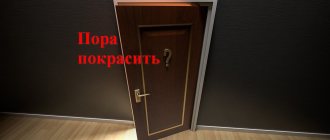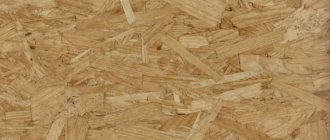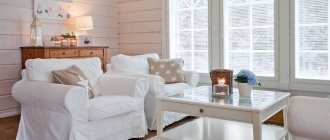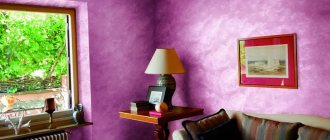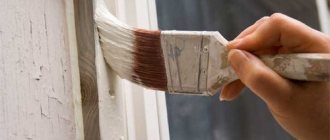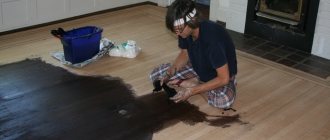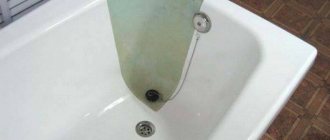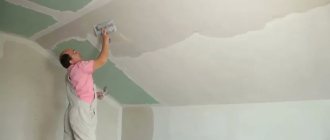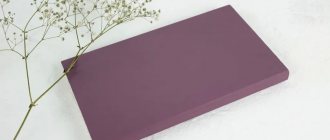Repair requires a lot of effort and time to make a high-quality update of the interior of an apartment or house. For this reason, many property owners want to reduce some of the work, especially when it comes to carrying out the finishing stage with their own hands. If the surface of the walls was previously painted, then beginners wonder: is it possible to apply paint over paint? The consequences of this decision, and in what cases this is permissible, will be discussed below.
What kind of paint can be applied to old paintwork?
Repair requires a lot of effort and time to make a high-quality update of the interior of an apartment or house. For this reason, many property owners want to reduce some of the work, especially when it comes to carrying out the finishing stage with their own hands. If the surface of the walls was previously painted, then beginners wonder: is it possible to apply paint over paint? The consequences of this decision, and in what cases this is permissible, will be discussed below.
Can paint be applied to paint?
Professionals do not recommend painting over another coloring material. For them, the stage of removing the old finish is mandatory. The reason is the danger of peeling off the previous coating, and if you apply a new layer on it, it will suffer along with the old one.
Having painted a light color on top, there is a high probability of noticing dark spots appearing through it. All flaws in the previous finish will be noticeable. In addition, not all paints and varnishes are compatible; their components may not fit each other, the layer will not apply well, and the degree of adhesion will be low.
Applying one layer to another is permissible only if the first one is in good condition, if it is perfect and lies securely on the surface. It is advisable to use similar paints and varnishes; it is optimal to paint the wall with the same types of paints.
For professionals, the stage of removing the old finish is mandatory.
Tree
There are two ways to remove old paint from wood:
- by firing;
- using chemical removers.
Both options have their drawbacks, which must be taken into account.
Thermal removal
Removing the coating with a hair dryer
- Removing paint by heat treatment is only suitable if the product can be taken out into the open air, since when heated, the paint releases highly toxic fumes, which can lead to poisoning in a closed room. Also, a small local fire of paint often occurs, which is also unacceptable in an enclosed space;
- This method is most effective when removing multi-layer paint - when heated, the coating swells with bubbles and peels off from the wood. If you are thinking about how to paint an old chest, then thermal cleaning is one of the best options;
- The main tools are a construction hair dryer and a spatula - the surface is heated with hot air until bubbles appear and the coating peels off, after which the paint is cleaned off with a spatula. Before removing old paint from wood, you can soften it using various solvent removers, which greatly facilitate its removal. Each type of paint has its own chemical composition for effective removal - this circumstance must be taken into account when purchasing this product;
Dry cleaning
Softening paint with chemical compounds
- This type of paint removal will be the optimal solution if you decide to remove the paint before painting the old chest of drawers - its bulkiness and complex design will not allow the use of thermal cleaning;
- To remove the paint coating, it is necessary to apply the mixture to the paint, after which it is advisable to wrap the product in polyethylene and leave for the recommended period of time. Depending on the type, the reagent will soften or completely dissolve the paint, and you can easily remove it with a spatula or rinse with water;
- The only drawback of this method is its high chemical activity (precautionary measures must be observed) and a rather weak effect on multi-layer old coating;
Note! Chemical treatment can only be used for products made from natural solid wood - MDF, plywood and other materials can react with the solvent and become unusable.
Before painting an old bedside table, puttying of chips and uneven spots is carried out.
Mechanical cleaning is ineffective and can severely damage the surface of the product. Since wood has a soft and pliable structure, sandblasting or brushing will leave deep grooves on the surface of the product and form chips that you will have to putty.
What kind of paint can be applied to oil paint?
If you need to paint in a short time and there is no way to waste time on removing the old finish, then there is an option when the paint layer can be applied to another one. You should check the integrity of the coating and whether it adheres firmly to the base.
The assessment is made visually; you should also run your hand over the surface; swelling can be detected using this method. If there are large defects, you cannot think about applying a new layer. Such a surface will repel new material quickly.
The oil composition has a glossy structure; it is the creation of an even film that helps protect the surface from moisture, for this reason it is often used for wood. But a smooth surface is not suitable for obtaining a good degree of adhesion. Therefore, the use of re-staining is difficult.
It would be correct to remove the paint; for this purpose, you can find special removers on sale; they soften the layer, after which you can remove the paint with a spatula. The process is not fast, but you get a good basis for repairs
If the base is in good condition, and you still decide to paint, then oil or alkyd enamel is more suitable for an oil base. You can also resort to acrylic; you will need to carry out the preparatory stage, applying a primer.
Compositions based on water are not a suitable option; in order to complete the polymerization, it is necessary to saturate the surface with water, and an oil coating will not allow it to pass to the base, so drying will not take place at the proper level, and reliable adhesion will not be obtained.
The oil composition has a glossy structure; it is the formation of an even film that helps protect the surface from moisture.
Special materials for painting automotive plastics
There are dozens of types of automotive paint materials. You can choose quality solutions for your car without overpaying a lot of money. But you shouldn’t skimp on primers and paint. A cheap primer can cause paint swelling or other unpleasant effects after just a few months. So when choosing materials, it is worth considering several important criteria for selecting reliable solutions:
- price - the cost of good materials for painting cars is quite high, but you should not give preference to the most expensive solutions, they are often not suitable for daily tasks;
- manufacturer - choose professional solutions that are well-known among you and in the professional world, this will help ensure a sufficiently high quality of the work performed;
- kit - make sure that the paint you purchase matches the primer you purchased, there are several options for mismatched materials that do not mix well;
- selection - if the color of the primer is not so important in the painting process, then the shade of the base material plays a huge role, perform a high-quality spectral selection of the material;
- Quantity - Don't buy much more paint than you need to complete the job, but it's worth taking a small supply to set up your equipment before painting.
As you can see, painting problems turn out to be quite serious. You need to approach the choice of materials correctly, combine them correctly, and not violate the technology of applying automotive paintwork. Otherwise, problems will not be avoided. Sooner or later, poorly applied paint will turn out to be swollen, cracked and peeling. Then you will have to invest a lot of money again and repaint the damaged areas again.
We invite you to watch a video about the process of preparing a bumper for painting:
Is it possible to paint with oil paint over oil paint?
Is it possible to paint with oil paint over oil paint? Many property owners who decide to refresh the color of the walls ask this question. This option is optimal if you need to skip the stage of removing the old coating. To get better adhesion, it is advisable to sand the base, removing the glossy layer.
To get better adhesion, it is advisable to sand the base, removing the glossy layer.
Painting process
Step by step guide to dyeing batteries:
- Turn off the heating and ventilate the room . It's worth waiting until it gets cold to prevent the paint from dripping. You should also make sure that the room is well ventilated. If you need to open several windows when the heating is turned off, then such a temporary cooling is still better than possible health problems associated with toxic paint composition.
- Clean the area around the radiator . It's best to use a vacuum cleaner to remove dust, hair, and anything that might stick to the paint. Then put any covering on the floor that you have at hand to prevent drops and splashes of paint.
- Apply (or spray) paint, ensuring that the layer is even . First of all, you need to paint the batteries inside, and then move on to the outside. Sections should be painted from top to bottom, otherwise the paint will fall on the already painted parts. If possible, it is better to avoid “overloading” the brush. If there is too much paint on the brush, it will cause drips and clumps.
- Wait , if necessary, apply another layer.
You must wait until the paint has completely dried. It is possible that the radiator may need another coat of paint once dry, but this is entirely dependent on the application process, the paint and the radiator. Most often, two coats are required for even painting. Moreover, two thin layers are better than one thick one. The second coat of paint is applied only after the previous one has completely dried.
The drying time of the paint is always indicated on the label.
Is it possible to paint with acrylic paint over oil paint?
The question of whether it is possible to paint with acrylic paint over oil paint can be answered in the affirmative. But a special type must be used - Master 121 paint. Taking into account that the surface has no flaws, the layer does not peel off or crack, only such a wall can be re-painted.
Master 121 is an acrylic enamel that is distinguished by its high adhesion to any type of substrate; it can even be applied to a glossy surface. This product will help to obtain a reliable and strong adhesion of the product to oil-type acrylic. But even the quality of good adhesion requires preliminary preparation of the base:
- First of all, the surface is sanded; fine-grained sandpaper is used for this purpose.
- The wall is washed, all dirt and grease should be removed.
- The surface must dry completely before painting; after the required time has passed, the wall is painted.
To improve the result, an equal amount of water should be added to the paintwork material; applying a more liquid product will make it easier to obtain an even and uniform distribution of the composition.
If you intend to distribute paint over the wall with a spray bottle, then you need to dilute it with special solvents.
Master 121 is an acrylic enamel that is distinguished by its high adhesion to any type of substrate.
Is it possible or not?
In fact, it is possible to apply a coloring composition to oil paint in cases where the surface will not be used intensively. For example, you can cover the ceiling in this way, but it is better to abandon this idea regarding the walls in the hallway. The fact is that after constant friction of the outerwear on the coating, it begins to wear off, and stains of the previous facing layer will begin to appear.
Using a brush to paint walls with water emulsion Source gidpokraske.ru
Is it possible to paint with alkyd paint over oil paint?
Often windows, radiators, ceilings and walls are painted with oil-based compounds. However, modern technologies have made it possible to create more advanced types of paints, for this reason many want to replace the material. Alkyd enamel has many advantages.
If an alkyd resin-based paint is chosen to repaint the paint, then the old oil-based coating must be removed. Only if the previous finish is securely fixed can re-painting be allowed.
Then the wall is sanded, the remaining dust and dirt after the process is washed off with an aqueous solution with soda. After the base has dried, the finished solution can be applied; several layers will be required, it is important that each of them is completely dry.
If an alkyd resin-based paint is chosen to repaint the paint, then the old oil-based coating must be removed.
Advantages of using water emulsion
Emulsion paint composition, like other facing materials, has its advantages. Worthy qualities include the following features:
- no chemical solvents are required for dilution;
- long service life of the coloring composition under conditions of light use;
- After painting, pores form on the coating; they allow the base to breathe, preventing the appearance of mold.
- has an unstable odor, so it disappears within a few hours after painting;
- it is consumed slowly but rationally, and this saves financial investments in repairs.
Painting the ceiling with a gray water emulsion using a wide brush Source sdelai-lestnicu.ru
Applying water-based paint to the ceiling using a spray gun Source gidpokraske.ru
Is it possible to paint with enamel over acrylic paint?
The acrylic type is distinguished by the presence of water in the composition, which contributes to the environmental friendliness of the composition, it does not smell unpleasant, and also does not emit harmful components when drying. The presence of water makes it possible to paint over other paints and varnishes, including enamels. First you need to clean the wall of dirt and apply a primer, then adhesion will be better. Of course, such finishing is only possible on strong substrates, without cracking.
The presence of water makes it possible to paint over other paints and varnishes, including enamels.
How to paint walls with water-based paint over oil-based paint
The water-based composition is also produced using water. To obtain the necessary fixation of the layer, it must be saturated into the base. But the oil composition will not give water such an opportunity, it will simply push it away from itself.
For this reason, part of the layer will adhere well, in those places where the gloss has come off, and part will simply not adhere. To avoid such consequences, apply a layer of drying oil; it will create a good base for adhesion. Or a primer solution is used.
To obtain the necessary fixation of the layer, it must be saturated into the base.
Aluminum batteries
Unfortunately, it is almost impossible to paint batteries made of aluminum or bimetal at home yourself. Such products are painted in factories using a special powder dye. It is applied using special equipment, and it is impossible to repeat this procedure at home.
Expert opinion
Grebnev Vadim Savelievich
Heating system installer
Photo printing can be used to restore the aesthetic qualities of aluminum batteries. The photographic image is attached to the outside of the batteries. It tolerates high temperatures and extremes very well.
What kind of paint can acrylic paint be applied to?
To paint an oil base with an acrylic composition, first apply a primer mixture; it will create the necessary level of adhesion of the two products. The water-based base must be ideal, then it will be possible to apply an acrylic-based product. But it is always better to remove the previous finish. Then the coloring will be of high quality.
It is possible to use a latex layer on top; it is important that the acrylic is of high quality. Then the degree of adhesion will be good, the compositions will be able to adhere well.
It is possible to use a latex layer on top; it is important that the acrylic is of high quality.
Is it possible to paint with oil paint on nitro enamel?
The oil type of wall painting material has an oily structure that is poorly compatible with nitro enamels. If you apply them on top of each other, the following problems may appear:
- Formation based on cracks and bubbles;
- Changing the shade of the product, which ultimately will not allow you to get the desired design of the room;
- The paint life will be short.
The oil type of wall painting material has an oily structure that is poorly compatible with nitro enamels.
Is it possible to paint with oil paint on enamel?
Oil base and enamels are similar in their components, which helps to use them together. If necessary, the formulations can be mixed together. It is also allowed to paint them on top of each other.
But the condition for the reliability of the base remains unchanged for any composition. The surface should be cleaned of all types of contaminants and thoroughly degreased. The new product should be applied in several layers. The importance of drying each one is undeniable, so don’t rush, otherwise the paint will be ruined and won’t last long.
The new product should be applied in several layers.
The article provided a detailed answer to the question: is it possible to apply paint to old paint? The technology of work includes the mandatory removal of old materials, but sometimes it is not possible to carry out this stage. Then the condition of the surface is assessed and compatible products are selected.
Full bumper painting - we prepare and carry out the procedure
Sometimes local restoration is impossible due to certain reasons. In this case, high-quality repainting is carried out. It is recommended to completely update the paintwork if several damages appear on the bumper in different places at once. In this case, we can say with confidence that most of the paintwork on plastic does not correspond to factory quality. To complete a complete repainting, you will have to perform a rather complex set of works:
- removing the bumper from its installation site so as not to damage the body and paint all hidden surfaces and edges efficiently, this will also make it easier to process the part for painting;
- removing all layers of paintwork that could cause problems with painting; they are removed using washing or special chemicals - choose a convenient method;
- drying and degreasing the surface with a solvent, checking for deformations and scratches, puttying or other type of leveling of the part before painting;
- using a primer for plastic in a can or in bottle form to apply a base for paint, this is a necessary stage, without which it is impossible to get a good result;
- painting the bumper, performing painting work using professional equipment and using good skills, otherwise problems cannot be avoided, the paint will peel off again.
You should not carry out repairs in a garage in winter or autumn, when you cannot provide normal temperatures and other conditions for drying paint. Otherwise, you will simply waste expensive materials. The choice of paint needs to be given great attention. Therefore, we will devote a separate section to this process and try to explain what requirements for painting materials are really important for choosing paint.

